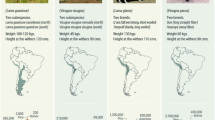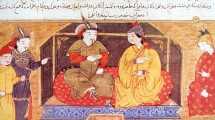Abstract
This paper examines the socio-political processes surrounding spectacular religious parades and more private acts of veneration and supplication within the Hueda Kingdom (c. 1650–1727 AD) in the Republic of Bénin, West Africa. The first goal of this paper is to posit the role that such public and private ceremonies played in framing negotiations of political and moral authority. It argues that ceremonial hosts and assembled audience members worked to channel toward their own interests the social, political, and economic outpouring that resulted from ritually sanctioned performances of wealth. The second goal of the paper is to illustrate material and spatial dimensions of such ceremonial spaces. These themes, drawn from a historically well-known polity, work together to aid in comparative theory building on feasting and the politics of spectacle in the deeper archaeological past.



Similar content being viewed by others
References
Akinjogbin, I. A. (1967). Dahomey and its neighbors 1708–1818. Cambridge: Cambridge University Press.
Arens, W., & Karp, I. (1989). Creativity of power: Cosmology and action in African societies. Washington, DC: Smithsonian Institution Press.
Argyle, W. J. (1966). The Fon of Dahomey: A history and ethnography of the Old Kingdom. Oxford: Clarendon Press.
Astley, T. (Ed.) (1745–1747). A new general collection of voyages and travels: Consisting of the most esteemed relations, which have been hitherto published in any language (Vol. 3). London.
Atkins, J. (1735). A voyage to Guinea, Brazil, and the West Indies. London.
Bakhtin, M. (1984). Problems of Dostoevsky’s poetics. Ann Arbor: University of Michigan Press. Edited and translated by Caryl Emerson.
Bakhtin, M. (1993). Rabelais and his world. Bloomington: Indiana University Press. Edited and translated by Hélène Iswolsky.
Bay, E. (1998). Wives of the Leopard: Gender politics, and culture in the kingdom of Dahomey. Charlottesville: University of Virginia Press.
Bay, E. (2008). Asen, ancestors, and vodun: Tracing change in African art. Urbana: University of Illinois Press.
Blier, S. (1996). African vodun: Art psychology, and power. Chicago: University of Chicago Press.
Bosman, W. (1705). A new and accurate description of the Coast of Guinea, divided into the gold, the slave, and the ivory coasts. London.
Dapper, O. (1970 [1686]). Description de l’Afrique, Contenant les Noms, la Situation & les Confines de toutes ses Parties…, New York, Johnson Reprint Corporation.
DeCorse, C. (1996). Documents, oral histories, and the material record: Historical archaeology in West Africa. World Archaeology, 7, 40–50.
Dietler, M. (2001). Theorizing the feast: Rituals of consumption, commensual politics, and power in African contexts. In M. Dietler & B. Hayden (Eds.), Feasts: Archaeological and ethnographic perspectives on food politics and power (pp. 65–114). Washington, DC: Smithsonian Institution Press.
Foucault, M. (1977). Discipline and punish: The birth of the prison. New York: Pantheon.
Guyer, J. (1993). Wealth in people and self-realization in Equatorial Africa. Man, 28, 243–265.
Guyer, J. I., & Belinga, S. E. (1995). Wealth in people as wealth in knowledge: Accumulation and composition in Equatorial Africa. Journal of African History, 36, 91–120.
Hair, P. E., Jones, A., & Law, R. (Eds.). (1992). Barbot on Guinea: The writings of Jean Barbot on West Africa 1678–1712, Volume II of II. London: The Hakluyt Society.
Herbert, E. (1993). Iron, gender, and power. Bloomington: Indiana University Press.
Herskovits, M. (1932). Some aspects of Dahomean ethnology. Africa, 5(3), 266–296.
Herskovits, M. (1938). Dahomey: An ancient West African kingdom (Vol. II). New York: J. J. Augustin.
Inomata, T., & Coben, L. S. (2006). Scene 1 overture: An invitation to the archaeological theatre. In T. Inomata & L. S. Coben (Eds.), Archaeology of performance: Theatres of power, community, and politics (pp. 11–44). Lanham, MD: Alta Mira.
Jackson, H. E., & Scott, S. L. (2003). Patterns of elite faunal utilization at Moundville, Alabama. American Antiquity, 68(3), 552–572.
Kelly, K. G. (1997a). The archaeology of African–European interaction: Investigating the social roles of trade, traders, and the use of space in the seventeenth and eighteenth century Hueda Kingdom, Republic of Bénin. World Archaeology, 28(3), 77–95.
Kelly, K. G. (1997b). Using historically informed archaeology: Seventeenth and eighteenth century Hueda/European interaction on the coast of Bénin. Journal of Archaeological Method and Theory, 4(3/4), 353–366.
Kelly, K. G. (2001). Change and continuity in coastal Bénin. In C. R. DeCorse (Ed.), West Africa during the Atlantic slave trade: Archaeological perspectives (pp. 81–100). London: Leicester University Press.
Kus, S. (1989). Sensuous human activity and the state: Towards an archaeology of bread and circuses. In D. Miller, M. Rowlands, & C. Tilley (Eds.), Domination and resistance (pp. 140–154). London: Unwin Hyman.
Labouret, H., & Rivet, P. (1929). Le Royaume d’Arda et son Évangélisation au XVII e siècle, Travaux et Mémoires de l’Institut d’Ethnologie No. 7, Paris, Institut d’Ethnologie.
Lau, G. F. (2002). Feasting and ancestor veneration at Chinchawas, North Highlands of Ancash, Peru. Latin American Antiquity, 13(3), 279–304.
Law, R. (1990). ‘The common people were divided’: Monarchy, aristocracy, and political factionalism in the Kingdom of Whydah, 1671–1727. International Journal of African Historical Studies, 23(2), 201–229.
Law, R. (1991a). Religion, trade, and politics on the ‘Slave Coast’: Roman Catholic missions in Allada and Whydah in the seventeenth century. Journal of Religion in Africa, 21(1), 42–77.
Law, R. (1991b). The Slave Coast of West Africa, 1550–1750: The impact of the Atlantic slave trade on an African society. Oxford: Clarendon Press.
Law, R. (2002). An alternative text of King Agaja of Dahomey’s letter to King George I of England, 1726. History in Africa, 29, 257–271.
Law, R. (2004). Ouidah: The social history of a West African slaving port, 1727–1892. Athens: Ohio University Press.
LeCount, L. J. (2001). Like water for chocolate: Feasting and political ritual among the Late Classic Maya at Xunantunich, Belize. American Anthropologist, 103(4), 935–953.
Lucero, L. J. (2003). The politics of ritual: The emergence of Classic Maya rulers. Current Anthropology, 44(4), 523–558.
Mauss, M. (2000). The gift: The form and reason for exchange in archaic societies. New York: Routledge. Translated and edited by D. W. Hall.
McIntosh, S. K. (1999). Pathways to complexity: An African perspective. In S. McIntosh (Ed.), Beyond chieftains: Pathways to complexity in Africa (pp. 1–30). Cambridge: Cambridge University Press.
Miller, J. C. (2004). Slaving and colonialism. Journal of Colonialism and Colonial History, 5(3), 1–62.
Monroe, J. C. (2007). Continuity, revolution or evolution on the Slave Coast of West Africa? Royal architecture and political order in precolonial Dahomey. Journal of African History, 48(03), 349–373.
Norman, N. L. (2008). An archaeology of West African atlanticization: Regional analysis of the Huedan palace districts and countryside (Bénin), 1650–1727. Ph.D. Dissertation, University of Virginia, Anthropology (sub-discipline: Archaeology).
Norman, N. L. (2009a). Hueda (Whydah) country and town: Archaeological perspectives on the rise and collapse of an African Atlantic kingdom. International Journal of African Historical Studies, 43(3), 387–410.
Norman, N. L. (2009b). Powerful pots, humbling holes, and regional ritual processes: Towards an archaeology of Huedan Vodun. African Archaeological Review, 26(3), 187–218.
Norman, N. L., & Kelly, K. G. (2004). Landscape politics: The serpent ditch and the rainbow in West Africa. American Anthropologist, 106(1), 98–110.
Palaima, T. G. (2004). Sacrificial feasting in the Linear B documents. Hesperia, pp. 217–46.
Pearson, M., & Thomas, J. (1994). Theatre/archaeology. TDR, 38(4), 133–161.
Phillips, T. (1732). A Journal of a Voyage Made in the Hannibal of London, Ann. 1693, 1694, From England to Cape Monseradoe, in Africa; and Thence Along the Coast of Guinea to Whidaw, the island of St. Thomas, and to Barbados: With a Cursory Account of the Country, the People, and their Manners, Forts, Trade, etc.…In Churchill, J. (ed.), A Collection of Voyages, London.
Piot, C. (1992). Wealth production, ritual consumption, and center/periphery relations in a West African regional system. American Ethnologist, 19(1), 34–52.
Polanyi, K. (1966). Dahomey and the slave trade: An analysis of an archaic economy. Seattle: University of Washington Press.
Ray, K. (1987). Material metaphor, social interaction, and historical reconstructions. In I. Hodder (Ed.), Exploring patterns of association and symbolism in the Igbo-Ukwu corpus (pp. 66–77). Cambridge: Cambridge University Press.
Schmidt, P. (1996). Rhythmed time and its archaeological implications. In G. Pwiti & R. Soper (Eds.), Aspects of African archaeology: Papers of the 10th Pan African Association for Prehistory and Related Studies (pp. 654–659). Harare: University of Zimbabwe Publications.
Smith, A. (2000). Rendering the political aesthetic: Political legitimacy in Urartian representations of the built environment. Journal of Anthropological Archaeology, 19, 131–163.
Steel, L. (2004). A goodly feast…a cup of mellow wine: Feasting in Bronze Age Cyprus. Hesperia, 73(2), 281–300.
Thornton, J. (1995). Africa and Africans in the making of the Atlantic world, 1400–1680. Cambridge: Cambridge University Press.
Turner, V. (1972). The ritual process. Ithaca, NY: Cornell University Press.
Voyages. (2008). Voyages: The trans-atlantic slave trade database. www.slavevoyages.org. Accessed 12 July 2010.
Acknowledgments
The author wishes to thank Adria LaViolette, Kenneth Kelly, J. Cameron Monroe, Jeffrey Hantman, Jerome Handler, and Joseph C. Miller for comments on earlier versions of this paper and/or the dissertation project from which it is drawn. I am indebted to Jeffrey Fleisher and Stephanie Wynne-Jones who offered detailed suggestions. Alexis Adandé served as the local coordinator of my project and offered his considerable knowledge of the archaeology of southern Bénin. Joseph Adandé, Obaré Bagodo, Souayibou Varissou, Bienvenue Olory, Didier N’dah, and Elisée Soumoni deserve special thanks for their kind encouragement and local logistical assistance. Early field efforts in 2003–2004 were supported by The Explorers Club Washington Group; the Graduate School of Arts and Science, University of Virginia (UVa); the Department of Anthropology, UVa; and the Center for Academic Excellence, UVa. The longer field campaign in 2005–2006 was funded by a National Science Foundation Dissertation Improvement Grant (#0432893), a Fulbright-Hays Doctoral Dissertation Research Abroad Fellowship (#P022A0500), and a special grant by the Embassy of the Netherlands to Cotonou. A grant from the Dean of the Faculty of Arts and Sciences at the College of William and Mary allowed for follow-up fieldwork in the summer of 2010. The paper was strengthened through the comments of two anonymous reviewers. All errors and omissions of fact are the sole responsibility of the author.
Author information
Authors and Affiliations
Corresponding author
Rights and permissions
About this article
Cite this article
Norman, N.L. Feasts in Motion: Archaeological Views of Parades, Ancestral Pageants, and Socio-Political Process in the Hueda Kingdom, 1650–1727 AD. J World Prehist 23, 239–254 (2010). https://doi.org/10.1007/s10963-010-9037-z
Published:
Issue Date:
DOI: https://doi.org/10.1007/s10963-010-9037-z




